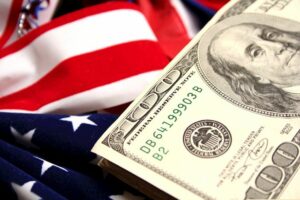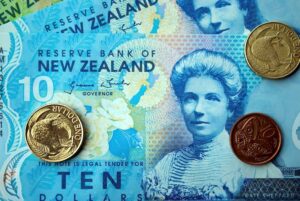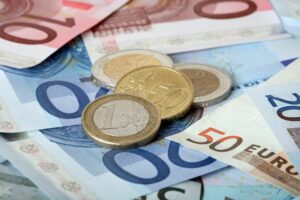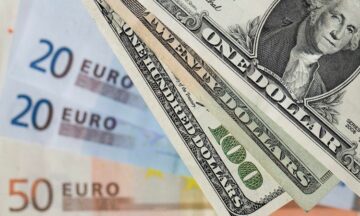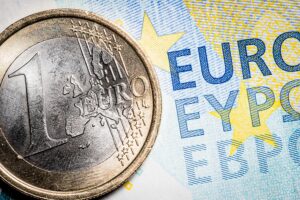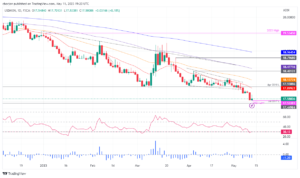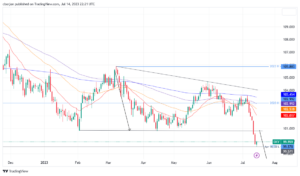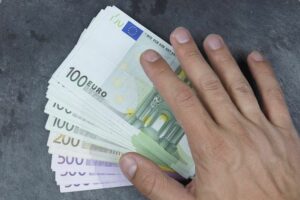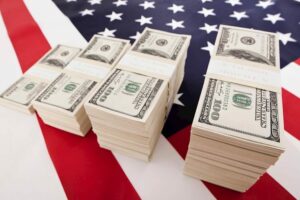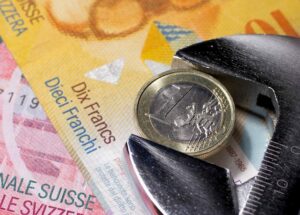
- The US Dollar trades at small loss in a dispersed market.
- Traders are left clueless ahead of the Fed meeting in two weeks.
- The US Dollar Index closed above important resistance, though fell back below it on Friday’s opening.
The US Dollar (USD) consolidates with lower highs and higher lows after the volatility pickup earlier this week. Traders are left clueless ahead of the first US Federal Reserve meeting to be held at the end of January. Although it becomes clear no rate cut will take place, traders have only delayed their rate-cut expectations until May, (from March), which makes it difficult for the Greenback to rally substantially.
On the economic front, the University of Michigan numbers could not trigger a substantial breakout either way. The Sentiment part jumpe dhigher to 78.8, from 69.7 and beating the 70.1 projected. Though the number got overshawed with the inflation expecations number heading from 2.9% to 2.8%. So one element in favor of the US Dollar with the inflation projection rather in favor of a lighter US Dollar.
Daily digest market movers: Michigan stand still
- US Chicago Federal Reserve member Austin Goolsbee spoke this Friday. The door is open for a rate cut, though more needs to be done on housing inflation. A reverse in inflation might need a rate hike. Inflation data will dictate the path forward on rates.
- Fresh US air strikes took place against Houthi rebels on Thursday evening.
- The Senate’s stopgap funding bill has had enough votes to pass and is now making its way to the House.
- Near 15:00 GMT the University of Michigan was released:
- The Consumer Sentiment Index for January went from 69.7 to 78.8.
- Inflation expectations went from 2.9% to 2.8%.
- US San Francisco Federal Reserve member Mary Daly be the last Fed speaker before the blackout period from the Fed takes place ahead of its first rate decision for 2024 at the end of January.
- Equity markets have shown resilience and have rebounded quite a lot. European equities are nearly erasing all incurred losses from this week and might head to a flat close for this week’s performance should the current gains be extended into the European close on Friday. US equities see the Dow Jones nearly paring back losses from earlier this week while the Nasdaq is already ahead of that option and is firmly in the green for this week’s close.
- The CME Group’s FedWatch Tool shows that markets are pricing in a 97.4% chance that the Federal Reserve will keep interest rates unchanged at its January 31 meeting. Around 2.6% expect the first cut already to take place.
- The benchmark 10-year US Treasury Note remains steady at 4.13%, making it a five-day winning streak.
US Dollar Index Technical Analysis: See you next week
The US Dollar Index (DXY) is caught between a rock and a hard place on the charts. Although the moves earlier this week looked bullish, it makes sense that the US Dollar was unable to steam away and perform a substantial rally on the DXY chart. Reason for that is that traders only have rebalanced their bets for an initial rate cut by the Fed from March to June, which indeed asks for some higher valuation of the US Dollar, though possibly not enough to move away from the 55-day and the 200-day Simple Moving Averages (SMA) near 103.33 and 103.46 respectively.
The DXY is trading smack in the middle of those two moving averages this Friday. In case the DXY can get through that area again and run away, look for 104.44 as the first resistance level on the upside, in the form of the 100-day SMA. If that gets scattered as well, nothing will hold the DXY from heading to either 105.88 or 107.20, the high of September.
Risk of a bull trap is still a possible outcome, where US Dollar bulls were caught buying into the Greenback when it broke above both the 55-day and the 200-day SMA in early Wednesday trading. Price action could decline substantially and force US Dollar bulls to sell their positions at a loss. This would see the DXY first drop to 102.60, at the ascending trend line from September. Once threading below it, the downturn is open to head to 102.00.
Davos 2024 FAQs
The World Economic Forum (WEF) is a not-for-profit organization that brings together global leaders from commerce, academia, philanthropy, and politics in an annual meeting in Davos, Switzerland, with the aim of jointly solving the global economic, social, and political challenges of the day. The WEF was started by Economist Klaus Schwab in 1971. The principle of stakeholder capitalism, in which corporations are not just accountable to shareholders but also to the wider public and the environment, is central to the WEF’s ethos, as is the use of Public-Private Partnerships (PPP) to achieve better outcomes.
In the words of the organizers, one of the major themes of Davos 2024 is “Rebuilding Trust,” which relates primarily to finding solutions to geopolitical fractures, such as the conflicts in Gaza and Ukraine. Another key theme is that of how AI can be a driving force for the economy and society. Hammering out a long-term strategy for climate and energy is high on the list of priorities, as is facing the threat of a potential economic slowdown.
The World Economic Forum’s board of trustees are drawn from all four corners of the globe. They consist of leaders from the worlds of business, politics, academia, philanthropy, the arts, and civil society. These include the CEOs of major corporations, heads and former heads of state, professors, and musicians to name but a few.
The World Economic Forum’s (WEF) main achievements have probably been in the realm of conflict resolution. The “Davos Declaration” of 1988 prevented the outbreak of a war between Greece and Turkey. The WEF led to the first ministerial-level meeting between North and South Korea. Davos was the meeting place for the first face-to-face meeting between Nelson Mandela and South African President F.W. de Klerk, which started off the dismantling of apartheid, and it sowed the seeds of the “Cairo Agreement” between Israel and Palestine in 1994.
Davos has been criticized for being a meeting of the elite that disenfranchises poorer nations through the promotion of global capitalism. It has been criticized for not representing the very stakeholders it purports to support, nor including in discussions those most affected by the problems being tackled by the World Economic Forum. Two examples are developing countries and lower-income groups. Other criticisms are that it is not sufficiently diverse and is merely a “talking shop” devoid of action and relevance.
- SEO Powered Content & PR Distribution. Get Amplified Today.
- PlatoData.Network Vertical Generative Ai. Empower Yourself. Access Here.
- PlatoAiStream. Web3 Intelligence. Knowledge Amplified. Access Here.
- PlatoESG. Carbon, CleanTech, Energy, Environment, Solar, Waste Management. Access Here.
- PlatoHealth. Biotech and Clinical Trials Intelligence. Access Here.
- Source: https://www.fxstreet.com/news/us-dollar-has-issues-breaking-down-the-bearish-wall-202401191230
- :has
- :is
- :not
- :where
- 1
- 102
- 107
- 15%
- 1994
- 20
- 2024
- 31
- 32
- 33
- 40
- 46
- 50
- 60
- 7
- 70
- 8
- 97
- a
- above
- Academia
- accountable
- Achieve
- achievements
- Action
- affected
- African
- After
- again
- against
- ahead
- AI
- aim
- AIR
- All
- already
- also
- Although
- an
- analysis
- and
- Animate
- annual
- Another
- ARE
- AREA
- around
- Arts
- AS
- At
- austin
- away
- back
- BE
- becomes
- been
- before
- being
- below
- Benchmark
- Bets
- Better
- between
- Bill
- board
- both
- breakout
- Brings
- Broke
- bull
- bull trap
- Bullish
- Bulls
- business
- but
- Buying
- by
- CAN
- Can Get
- capitalism
- case
- caught
- central
- CEOs
- challenges
- Chance
- Chart
- Charts
- chicago
- civil
- clear
- Climate
- Close
- closed
- CME
- Commerce
- conflict
- conflicts
- Consolidates
- consumer
- consumer sentiment
- content
- corners
- Corporations
- could
- countries
- criticisms
- Current
- Cut
- data
- davos
- day
- de
- decision
- Decline
- Delayed
- developing
- Developing Countries
- dictate
- difficult
- Digest
- discussions
- dismantling
- dispersed
- diverse
- Dollar
- dollar index
- done
- Door
- dow
- Dow Jones
- DOWNTURN
- drawn
- driving
- Drop
- Dxy
- Earlier
- Early
- Economic
- Economic Forum
- Economist
- economy
- either
- element
- elite
- end
- ends
- energy
- enough
- Environment
- Equities
- Ethos
- European
- European equities
- evening
- examples
- expanded
- expect
- expectations
- extended
- facing
- FAQ
- favor
- Fed
- fed meeting
- Federal
- federal reserve
- few
- finding
- firmly
- First
- flat
- For
- Force
- form
- Former
- Forum
- Forward
- four
- Francisco
- Friday
- from
- front
- funding
- Gains
- geopolitical
- get
- Global
- Global Economic
- globe
- GMT
- got
- Greece
- Green
- Greenback
- Group’s
- had
- Hard
- Have
- head
- Heading
- heads
- Held
- High
- higher
- Highs
- Hike
- hold
- House
- housing
- How
- HTTPS
- if
- important
- in
- include
- Including
- incurred
- index
- inflation
- initial
- interest
- Interest Rates
- into
- Israel
- IT
- ITS
- January
- jones
- jpg
- june
- just
- Keep
- Key
- klaus
- korea
- Last
- leaders
- Led
- left
- Level
- levels
- lighter
- Line
- List
- long-term
- Look
- looked
- loss
- losses
- Lot
- lower
- Lows
- Main
- major
- MAKES
- Making
- March
- Market
- Markets
- mary
- May..
- meeting
- member
- merely
- Michigan
- Middle
- might
- module
- more
- most
- move
- Movers
- moves
- moving
- moving averages
- musicians
- name
- Nasdaq
- Nations
- Near
- nearly
- Need
- needs
- next
- no
- nor
- North
- note
- nothing
- now
- number
- numbers
- of
- off
- on
- once
- ONE
- only
- open
- opening
- Option
- or
- organization
- organizers
- Other
- out
- outbreak
- Outcome
- outcomes
- Palestine
- part
- partnerships
- pass
- path
- perform
- performance
- period
- PHILANTHROPY
- Pickup
- Place
- plato
- Plato Data Intelligence
- PlatoData
- political
- politics
- positions
- possible
- possibly
- potential
- PPP
- president
- prevented
- price
- PRICE ACTION
- pricing
- primarily
- principle
- probably
- problems
- projected
- Projection
- promotion
- public
- quite
- rally
- Rate
- Rate Hike
- Rates
- rather
- realm
- reason
- relates
- released
- relevance
- remains
- representing
- Reserve
- resilience
- Resistance
- Resolution
- respectively
- reverse
- Rock
- Run
- San
- San Francisco
- scattered
- see
- seeds
- sell
- sense
- sentiment
- September
- Shareholders
- should
- shown
- Shows
- Simple
- Slowdown
- SMA
- small
- So
- Social
- Society
- Solutions
- Solving
- some
- South
- South African
- South Korea
- Speaker
- stakeholder
- stakeholders
- stand
- started
- starts
- State
- steady
- Steam
- Still
- Strategy
- Strikes
- substantial
- substantially
- such
- support
- switzerland
- Take
- takes
- Technical
- Technical Analysis
- that
- The
- the Fed
- the world
- their
- theme
- themes
- These
- they
- this
- this week
- those
- though?
- threat
- Through
- thursday
- to
- together
- took
- tool
- Traders
- trades
- Trading
- trapped
- treasury
- Trend
- trigger
- Trust
- Turkey
- two
- Ukraine
- unable
- university
- University of Michigan
- until
- Upside
- us
- US Dollar
- US Dollar Index
- US Equities
- US Federal
- us federal reserve
- US Treasury
- USD
- use
- Valuation
- very
- Volatility
- votes
- W
- war
- was
- Way..
- Wednesday
- week
- Weeks
- WEF
- WELL
- went
- were
- when
- which
- while
- wider
- will
- winning
- with
- words
- world
- World Economic Forum
- World Economic Forum (WEF)
- world’s
- would
- you
- zephyrnet

